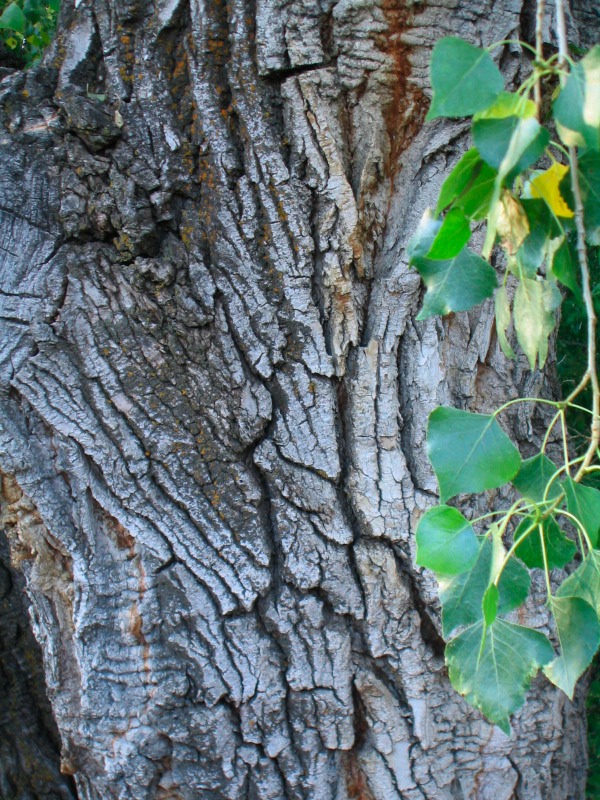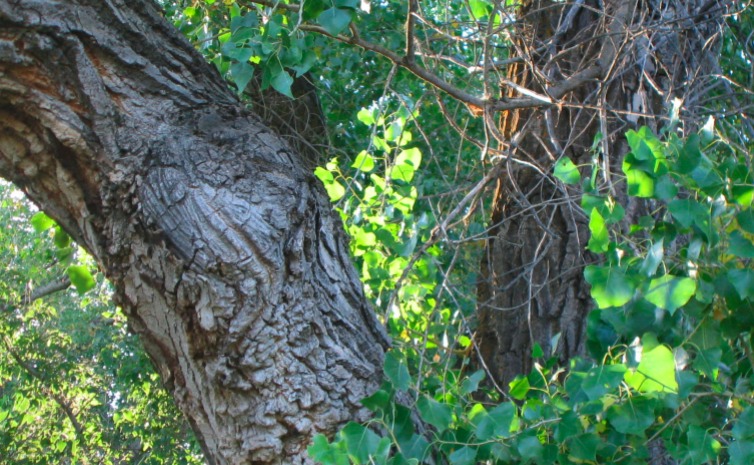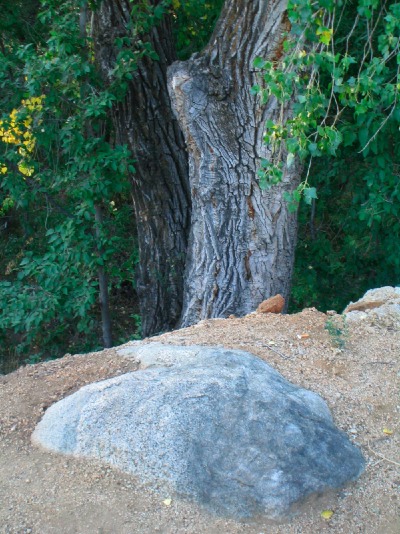It’s a treat to return in August to Prescott, Arizona, with its annual din of cicadas. Today, as I approach the corridor of trees lining summer-dry Granite Creek, the chorus of insects in the treetops is boisterous. Eagerly I slip under their canopy of sound, as if sliding into a tingly bath.
Before visiting this town seven years ago, I’d never heard such a din. Locusts in my Ohio childhood sawed their songs in melancholy rhythms during July and August, but here in Arizona the cicadas swell in a chorus so blaring they drown out human conversation.
Just as well. I have come alone to the creek to sit and gaze at a tree.
The tree in front of me wears gray-tan bark, roughened with deep creases that weave gracefully up and down the trunk. This tree is a cottonwood, a tree that loves to keep its feet wet and is found along the riparian corridors of the Southwest. Some of this tree’s limbs are lighter in color, their smooth whitish surface reminding me of my first tree love, a birch. I feel at home with this tree and its companions lining the creek.
I send a feeling of appreciation to the tree—for its being in the world, for the clean air it provides by soaking up exhaust fumes from the nearby street. I love its heart-shaped leaves, and the way sunlight seeps through their green solidity, rendering them translucent to the dance of shadows from leaves farther up. From the trunk and main limbs pour small sucker branches, their leafy clusters identical in outline to clusters of grapes ripe for plucking.

If you sit with a tree, like this, simply noticing and appreciating every detail you can, you may find yourself settling deeper into quietness, deeper into your body. And as you move deeper into yourself, paradoxically you may find that you move somehow deeper into the tree as well. The quieter you allow your mind to become—soaking up details of this particular tree, this sunlight in these leaves at this moment—the more you may find that your awareness moves not toward the minute but toward the whole. By noticing the smallest feature of bark or leaf, your mind may become quiet enough to take in, paradoxically, the entire tree. And then, even more quietly, you may slip unnoticed into the tree itself. You may find yourself exploring what it feels like to plant your roots in a creekbed and remain, just that way, for decades, sheltering a din of cicadas in your branches in late summer and then, when cool nights lengthen, offering up your harvest of leaves.
 And if you can settle even more quietly, your mind aware of the feeling of your roots in damp earth and your branches spreading into light, you might find yourself able one day to take in your surroundings as well: rock beside you, houses just up the rise, cars on the street—perhaps the entire landscape present to you with no effort on your part. Then you feel graced with a sense of peace, of fullness, a simple fact of presence.
And if you can settle even more quietly, your mind aware of the feeling of your roots in damp earth and your branches spreading into light, you might find yourself able one day to take in your surroundings as well: rock beside you, houses just up the rise, cars on the street—perhaps the entire landscape present to you with no effort on your part. Then you feel graced with a sense of peace, of fullness, a simple fact of presence.
And when it is time to collect yourself gently from those roots, to withdraw quietly from those waving branches, you might blink slowly, take a deeper breath, and become aware again of this body sitting on this bench, beside the tree now, a companion again, a separate body with its separate purposes.
You stretch and breathe again and stand and begin to make your way back along the path. The world is just as it was—except now you notice you feel refreshed. A small piece of all-being-well has returned with you from your visit to the tree, and you are cleaner, simpler on the inside and so can make your way more easily in the outside world than you could before. . . .
Update: This post found its way into my book, Kissed by a Fox: And Other Stories of Friendship in Nature. More info about the book at kissedbyafox.com.